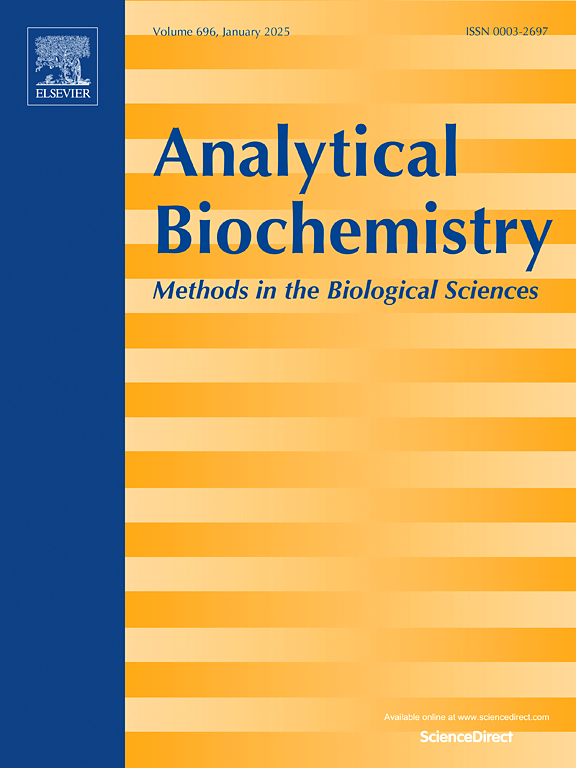Rapid screening plate of cadmium-chelating activity based on a quaternary complex of Cd(II)-Chrome azurol S CAS-2,2′-dipyridyl dipy-cetylpyridinium bromide CPB
IF 2.5
4区 生物学
Q2 BIOCHEMICAL RESEARCH METHODS
引用次数: 0
Abstract
Heavy metal ions, such as Cd, Hg, Pb, and As, tend to persist in soil without natural degradation and can be absorbed by crops, leading to the accumulation of agricultural products that pose a significant threat to human health. However, the development of a rapid and efficient technique for identifying heavy metals in agricultural products is essential to ensure health and safety. With the knowledge of the extent of damage caused by heavy metals, it becomes imperative to detect the presence of cadmium in the soil, water, and the environment. This study introduces a novel plate approach for quick and precise colorimetric detection of cadmium ions using the Cd(II)-Chrome Azurol S CAS-2,2′-dipyridyl dipy-Cetylpyridinium Bromide CPB quaternary complex. Our innovative method has shown that at a reaction solution pH of 11, the optimal concentration ratio is CAS (5 × 10−3 M): dipy (0.1 M): CPB (1.0 × 10−3 M) = 4 mL: 1 mL: 1 mL. The most significant fading alert was observed when the ethylenediaminetetraacetic acid (EDTA) chelator was added dropwise to the CAS detection plate, indicating strong chelation of Cd by EDTA. This laboratory-based study established a foundation for future applications in real environmental sample analysis.

基于Cd(II)-铬Azurol S- cas -2,2′-二吡啶-十六烷基溴化吡啶CPB的四元配合物螯合镉活性的快速筛选板
镉、汞、铅、砷等重金属离子往往不经自然降解而持续存在于土壤中,可被作物吸收,导致农产品积累,对人体健康构成重大威胁。然而,开发一种快速有效的技术来鉴定农产品中的重金属,对于确保健康和安全至关重要。随着对重金属危害程度的认识,检测土壤、水和环境中镉的存在变得势在必行。本文介绍了一种利用Cd(II)-铬azurrol S cas -2,2′-二吡啶-十六烷基溴化吡啶CPB四元配合物快速、精确比色检测镉离子的新方法。我们的创新方法表明,在反应溶液pH为11时,最佳浓度比为CAS (5×10-3 M): dipy (0.1 M): CPB (1.0×10-3 M) = 4 mL: 1 mL: 1 mL。当在CAS检测板上滴入乙二胺四乙酸(EDTA)螯合剂时,褪色报警最显著,表明EDTA对Cd有较强的螯合作用。本实验室研究为未来在实际环境样品分析中的应用奠定了基础。
本文章由计算机程序翻译,如有差异,请以英文原文为准。
求助全文
约1分钟内获得全文
求助全文
来源期刊

Analytical biochemistry
生物-分析化学
CiteScore
5.70
自引率
0.00%
发文量
283
审稿时长
44 days
期刊介绍:
The journal''s title Analytical Biochemistry: Methods in the Biological Sciences declares its broad scope: methods for the basic biological sciences that include biochemistry, molecular genetics, cell biology, proteomics, immunology, bioinformatics and wherever the frontiers of research take the field.
The emphasis is on methods from the strictly analytical to the more preparative that would include novel approaches to protein purification as well as improvements in cell and organ culture. The actual techniques are equally inclusive ranging from aptamers to zymology.
The journal has been particularly active in:
-Analytical techniques for biological molecules-
Aptamer selection and utilization-
Biosensors-
Chromatography-
Cloning, sequencing and mutagenesis-
Electrochemical methods-
Electrophoresis-
Enzyme characterization methods-
Immunological approaches-
Mass spectrometry of proteins and nucleic acids-
Metabolomics-
Nano level techniques-
Optical spectroscopy in all its forms.
The journal is reluctant to include most drug and strictly clinical studies as there are more suitable publication platforms for these types of papers.
 求助内容:
求助内容: 应助结果提醒方式:
应助结果提醒方式:


